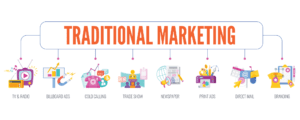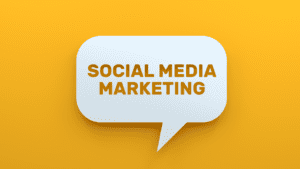5 Contrast of Social Media vs. Traditional Marketing


In the ever-evolving realm of marketing, businesses are faced with a critical decision: should they stick with the tried-and-true methods of traditional marketing or embrace the dynamic landscape of social media marketing? In this blog post, we’ll explore the strengths and weaknesses of each approach to help you make informed decisions about your marketing strategy.
Traditional Marketing: A Time-Tested Approach

Traditional marketing encompasses the conventional channels we’ve known for decades, including television, radio, print, and outdoor advertising. Despite the rise of digital alternatives, traditional marketing methods still hold their ground in various industries.
Conventional marketing is a type of advertising that reaches consumers through offline media. The following are important details of traditional marketing to be aware of:
a) Print, radio, direct mail, phone, and outdoor advertising such as billboards are all examples of traditional marketing.
b) It has been a tried-and-true approach to audience outreach and is still regarded as a successful marketing tactic.
c) Billboards, direct mail, TV and radio commercials, and newspaper ads are a few examples of classic marketing techniques.
d) Traditional marketing is still a viable and significant strategy for promoting some businesses, particularly when aiming to reach remote or older populations.
e) It is a more direct method of reaching out to worldwide target audiences.
f) Conventional marketing is among the most studied kinds of marketing, in addition to being one of the oldest.
g) Because this approach is established and tested, marketers tend to favour it.
h) Reaching local audiences is facilitated in large part by traditional marketing.
i) Brands may reach a wide spectrum of demographics with traditional marketing.
k) Traditional marketing has certain disadvantages as well, like little to no consumer connection and challenging campaign measurement.
l) The decision between traditional and digital marketing ultimately comes down to the particular requirements of a business; frequently, a combination of the two may be the most successful strategy.
Advantages of Traditional Marketing:
1. Established Credibility: Consumers often associate traditional marketing channels with legitimacy and credibility, especially when featured in reputable outlets.
2. Broad Reach: Television and radio advertisements can reach a large, diverse audience, making them suitable for campaigns aiming for widespread brand recognition.
The following are some of the benefits of traditional marketing:
- Local Audience Connection: For companies that depend on local client ties, traditional marketing is essential for connecting with and engaging local audiences.
- Credibility Establishment: Conventional marketing lends a corporation greater psychological credibility than internet marketing, contributing to the gradual development of trust and credibility.
- Diverse Audience Reach: Traditional marketing works well for mass marketing and reaching a wider audience since it enables firms to connect with a wide range of demographics.
- Tangibility and Trust: Conventional marketing enables companies to produce tangible marketing materials that clients can interact with and handle in person, fostering a sense of trust and leaving a trace.
- Widely Accepted and Flexible: Most firms agree that traditional marketing is a good strategy, and it may be highly adaptable, enabling the launch of multiple campaigns at different times and in diverse ways.
These benefits show how powerful and relevant traditional marketing is in some situations.
Drawbacks of Traditional Marketing:
1. High Costs: Running ads on television or in print can be expensive, limiting access for smaller businesses with tighter budgets.
2. Limited Interactivity: Traditional marketing lacks the real-time engagement and interaction that modern consumers seek.
Traditional marketing’s shortcomings also include:
- Expenses: Since traditional marketing frequently entails the creation and distribution of tangible marketing materials like brochures, flyers, and billboards, it can be more costly than digital marketing.
- Limited Targeting: In comparison to digital marketing, it usually aims for a wider audience and could not be as successful in targeting particular niche markets.
- Difficulty in Gathering Data: In contrast to digital marketing, traditional marketing initiatives can be difficult to quantify through data gathering, which makes tracking return on investment (ROI) a challenge.
- Limited Customer Interaction: It is challenging to gauge how customers will respond to marketing initiatives because traditional marketing does not have the same level of interactivity as digital marketing.
- Technology Dependence: Since digital marketing depends so largely on technology, it can be detrimental to companies that don’t have the funds or technical know-how to invest in it.
These shortcomings draw attention to a few of the difficulties that come with traditional marketing, especially when compared to digital marketing.
Social Media Marketing: The Digital Frontier

With the advent of social media, a new era of marketing emerged, characterized by real-time interactions, targeted advertising, and community building. Platforms like Facebook, Instagram, Twitter, and LinkedIn have become powerful tools for businesses looking to connect with their audience more dynamically.
Digital marketing techniques such as social media marketing make use of the popularity of social media platforms to reach audiences, establish companies, boost sales, and improve website traffic. It includes setting up business accounts, sharing informative information, interacting with followers, evaluating outcomes, and putting out social media ads.
Important aspects of social media marketing are as follows:
- It is an effective means of reaching potential clients and customers for companies of all sizes.
- Paid social media advertising is a necessary component of a dynamic strategy for social media marketing, which also calls for quantifiable objectives.
Facebook, Instagram, Twitter, LinkedIn, Pinterest, YouTube, and Snapchat are some of the most popular social networking sites.
The majority of social media platforms come with built-in data analytics capabilities and social media marketing is growing in popularity among practitioners and researchers alike. - With more than 4.76 billion social media users worldwide as of the beginning of 2023, it is a vibrant and ever-evolving field.
Planning, publishing, engaging, and analysing are all necessary components of a successful social media marketing strategy, and firms must have a firm grasp of their objectives and target market. - An outline of the definition and important components of social media marketing may be found in these points.
Advantages of Social Media Marketing:

1. Cost-Effective: Social media platforms provide cost-effective advertising options, making them accessible to businesses of all sizes.
2. Targeted Advertising: The ability to target specific demographics and interests allows for highly personalised and effective campaigns.
3. Real-time Interaction: Social media fosters instant communication, creating a sense of community and enhancing brand loyalty.
The following are some benefits of social media marketing for businesses:
a) Reaching huge audiences: Compared to traditional marketing initiatives, social media platforms enable firms to reach a wider audience at a cheaper cost.
b) Direct connection with the audience: Social media gives companies a direct line of communication with their clients, giving them a forum for interaction and feedback.
c) Generating organic content: Companies don’t need to pay extra to produce and distribute worthwhile material on social media platforms.
d) Access to paid advertising services: To help businesses expand their reach and visibility, social media platforms provide choices for sponsored advertising.
e) Building brand: Consistently sharing material on social media sites fosters brand loyalty and recognition.
f) Increasing website traffic: Social media marketing can boost website traffic, which in turn generates more leads and revenue for a company.
g) Performance evaluation: Companies can monitor and assess their social media performance, which enables them to enhance their marketing strategy and make data-driven decisions.
h) Increased brand recognition: Businesses can contact new clients and raise their brand awareness using social media marketing.
i) Better consumer engagement: Social media platforms allow companies to interact with their clients, respond to queries, and handle issues, which strengthens client connections and fosters customer loyalty.
j) Cost-effective marketing: Social media marketing appeals to small businesses because it is typically less expensive than traditional marketing techniques.
To sum up, social media marketing has a lot to offer companies: better consumer involvement, more brand awareness, cost-effective marketing, more website traffic, and greater search engine rankings. Businesses may engage with their target audience, forge enduring bonds with clients, and ultimately spur growth and success by using the power of social media.
1. Algorithm Changes: The ever-changing algorithms on social media platforms can impact the visibility of content, requiring constant adaptation.
2. Saturation: The sheer volume of content on social media can make it challenging for businesses to stand out and capture their audience’s attention.
Striking a Balance: Integrated Marketing Strategies
Rather than an either-or scenario, the most successful marketing strategies often involve a blend of both traditional and social media approaches. Integrating these methods allows businesses to leverage the strengths of each, reaching a diverse audience while fostering meaningful online interactions.
Using an integrated marketing strategy has the following advantages:
a) Enhanced efficiency: processes are streamlined and uniformity is maintained across all channels with an integrated marketing strategy, which improves outcomes and lowers waste.
b) Accessibility to wider audiences: By utilizing a variety of channels, integrated marketing enables companies to access a greater number of clients, hence expanding their overall reach.
c) Cost-effectiveness: Integrated marketing can lower marketing expenses and give firms a more affordable option by utilising pre-existing content and resources.
d) Builds trust: Brand loyalty and customer trust are fostered by consistent messages across all channels.
e) Better brand awareness: A cohesive brand message and image aid in raising brand recognition and awareness.
f) Better results: Because integrated marketing strategies target the proper demographic and convey a consistent message, they are more likely to provide better results.
g) Better customer experience: More sales and more customer satisfaction are the results of a smooth customer experience across all channels.
h) Streamlined management: Businesses may more easily manage their marketing activities thanks to integrated marketing, which streamlines campaign coordination and management.
i) Increased morale: By fostering cooperation and teamwork, a well-executed integrated marketing strategy can raise staff morale and productivity.
In conclusion, there are several advantages to integrated marketing strategies, such as increased productivity, cost-effectiveness, accessibility to a wider audience, brand awareness, better outcomes, enhanced customer satisfaction, simplified administration, and higher morale. Businesses can improve their entire marketing efforts by putting into practise an integrated marketing strategy.
Disadvantages of Social Media Marketing:
The disadvantages of social media marketing include:

a) Time-consuming: Maintaining an effective social media presence requires a significant investment of time and resources, including creating and curating engaging content, managing multiple social media platforms, maintaining a consistent brand experience, and responding to customer inquiries.
b) Negative feedback: Social media platforms allow users to share both positive and negative experiences, which can be visible to all other audiences, potentially damaging a business’s reputation.
c) Return on investment can be slow in social media marketing, and it may take time to see the expected results.
d) Security and privacy policy issues: Social media platforms have faced security and privacy issues in the past, which can be a concern for businesses.
In conclusion, while social media marketing offers numerous benefits, it also has its drawbacks, including time-consuming, negative feedback, low ROI, security and privacy policy issues, being limited only to social media platforms, heavily relying on ads, being difficult to measure, the need to stay engaged and active, not being built for businesses, and not working for all groups of people. Businesses should carefully consider these factors before implementing a social media marketing strategy.
Conclusion: Adapting to the Future (5 Contrast of Social Media vs. Traditional Marketing)
In the ongoing debate between social media marketing and traditional marketing, the answer lies in adaptability. Businesses that can seamlessly navigate both the traditional and digital landscapes are poised for success. The key is understanding your target audience, aligning your goals, and crafting a strategy that combines the best of both worlds.
As we navigate the ever-shifting marketing landscape, one thing remains clear: a holistic approach that integrates traditional and social media marketing is the way forward. Stay tuned for more insights into the world of marketing, and remember, the future belongs to those who can adapt.







